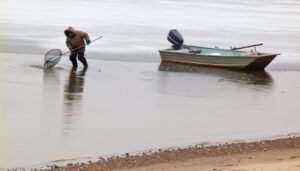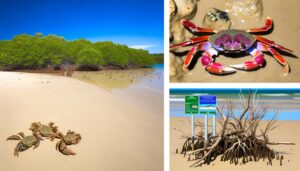How to Identify There Mud Crabs in Florida Waters
Yes, you can find mud crabs in Florida. Two common species are the Atlantic mud crab (Panopeus herbstii) and the flatback mud crab (Eurypanopeus depressus).
These crabs thrive in estuarine habitats like mangroves, salt marshes, and tidal flats. They have robust claws and their diet includes detritus, small fish, and mollusks.
Mud crabs play crucial roles in regulating prey populations and promoting biodiversity. Their presence indicates healthy marine ecosystems.
However, threats like habitat destruction and pollution impact their numbers. Explore further to understand their ecological importance and ongoing conservation efforts.

Key Takeaways
- Mud crabs are present in Florida, with species such as Panopeus herbstii and Eurypanopeus depressus.
- These crabs inhabit estuarine environments like mangroves, salt marshes, and tidal flats.
- Mud crabs thrive in brackish conditions and prefer substrates that allow burrowing.
- They play crucial ecological roles by regulating prey populations and enhancing nutrient cycling.
- Conservation efforts focus on habitat restoration and pollution control to protect mud crab populations.
Mud Crab Species in Florida
In Florida, you'll find several species of mud crabs, including Panopeus herbstii and Eurypanopeus depressus, each adapted to different coastal environments.
These crabs belong to the family Panopeidae, characterized by their robust claws and cryptic coloration.
Panopeus herbstii, commonly known as the Atlantic mud crab, exhibits a carapace width of up to 35 mm and thrives in estuarine habitats.
Eurypanopeus depressus, or flatback mud crab, features a more flattened body structure, aiding its burrowing behavior.
Both species play pivotal roles in the ecosystem, influencing sediment dynamics and serving as prey for larger predators.
Their presence is indicative of healthy, functioning marine systems, showcasing the biodiversity integral to Florida's coastal regions.
Natural Habitats
Understanding the natural habitats of mud crabs in Florida reveals their preference for estuarine environments rich in organic matter and sheltered from strong currents. You'll find them thriving in mangroves, salt marshes, and tidal flats. These habitats provide essential nutrients and protection from predators.
Mud crabs favor areas with muddy or sandy substrates where they can burrow and hide. They also depend on detritus and decaying vegetation found in these ecosystems. Estuarine habitats offer a mix of fresh and saltwater, creating brackish conditions ideal for mud crabs.
These environments not only support their physical needs but also contribute to their reproductive success by providing nursery grounds for larvae. Understanding these habitats is key to conserving mud crab populations.
Behavior and Diet
You'll find that mud crabs in Florida exhibit a variety of feeding habits, primarily scavenging on detritus and preying on small invertebrates.
Their social interactions are characterized by territorial behaviors and occasional aggression, especially during mating seasons.
Understanding these patterns helps in comprehending their ecological role and managing their populations effectively.
Feeding Habits Overview
Mud crabs in Florida exhibit opportunistic feeding behavior, primarily preying on small fish, mollusks, and detritus. You'll find that these crabs use their powerful claws to crush the shells of mollusks, making them effective predators. They also scavenge detritus, which consists of organic matter, providing them with essential nutrients.
Their diet flexibility allows them to thrive in various habitats, from estuaries to mangroves.
Research indicates that mud crabs have a significant impact on the local ecosystem by controlling the population of their prey. Their feeding habits also contribute to the cycling of nutrients in their environment. Understanding these habits can offer insights into their ecological role and help manage their populations effectively.
Social Interaction Patterns
In addition to their diverse feeding habits, mud crabs in Florida exhibit complex social interaction patterns that greatly impact their behavior and diet. You'll notice that their social structures influence how they forage, compete, and respond to environmental changes. These behaviors are essential for their survival and reproduction.
- Territoriality:
Mud crabs aggressively defend their burrows, which serve as both shelters and feeding grounds.
- Hierarchical Dominance:
Dominance hierarchies dictate access to resources, with larger crabs often monopolizing prime foraging areas.
- Communication:
They use chemical signals and physical displays to communicate, affecting mating and feeding behaviors.
- Avoidance and Escape:
Subordinate crabs often exhibit avoidance behaviors to reduce conflict, impacting their feeding efficiency.
Understanding these patterns helps in comprehending their ecological roles and management.
Ecological Importance
Mud crabs play an important role in maintaining the health and stability of Florida's coastal ecosystems by regulating prey populations and promoting biodiversity. They control the numbers of smaller invertebrates, preventing overpopulation that could lead to habitat degradation. By burrowing and foraging, mud crabs also enhance sediment turnover, improving nutrient cycling and water quality. Their presence supports a balanced food web that benefits numerous marine species.
Here's a table to highlight their ecological roles:
| Ecological Function | Impact on Ecosystem |
|---|---|
| Prey Regulation | Controls small invertebrate populations |
| Sediment Turnover | Enhances nutrient cycling |
| Food Source | Sustains larger predators |
| Habitat Structuring | Promotes biodiversity |
| Water Quality | Improves through bioturbation |
Understanding these roles underscores their ecological importance.
Threats and Conservation
Despite their important ecological roles, mud crabs in Florida face significant threats from habitat destruction, pollution, and climate change. You must understand these threats to help in their conservation.
Habitat destruction, particularly from coastal development, reduces the availability of essential breeding and feeding grounds. Pollution, including agricultural runoff and plastic waste, contaminates the water and harms their health. Climate change exacerbates these problems by altering water temperatures and salinity, affecting their survival.
To conserve mud crabs, you should:
- Support habitat restoration projects that aim to rebuild important coastal areas.
- Advocate for stricter pollution controls to reduce contaminants in waterways.
- Promote sustainable coastal development that minimizes habitat destruction.
- Educate others about the ecological importance of mud crabs and the threats they face.
Understanding and addressing these threats is crucial for the conservation of Florida's mud crabs.
Research and Observations
Ongoing research and field observations provide invaluable insights into the behavior, population dynamics, and ecological impact of mud crabs in Florida's coastal ecosystems. You'll find that studies often focus on their feeding habits, reproductive cycles, and habitat preferences. Researchers use a variety of methods, including direct sampling and remote sensing, to gather data. This information helps in understanding the species' role within the ecosystem and in developing conservation strategies.
| Aspect | Findings |
|---|---|
| Feeding Habits | Omnivorous, prefer bivalves and detritus |
| Reproductive Cycles | Seasonal, peaks in warmer months |
| Habitat Preferences | Mangroves, estuaries, and intertidal zones |
| Population Dynamics | Influenced by predation and environmental factors |
Conclusion
You'll find mud crabs in Florida's coastal waters, contributing significantly to the ecosystem. Remarkably, a single mud crab can consume up to 40 juvenile oysters daily, showcasing their role in controlling oyster populations.
These crabs are essential for maintaining ecological balance, but they face threats from habitat loss and pollution. Conservation efforts are important to protect these essential creatures.
Ongoing research provides valuable insights, helping to guarantee their survival and the health of their habitats.






